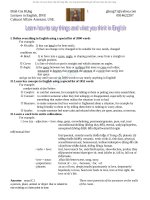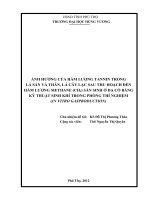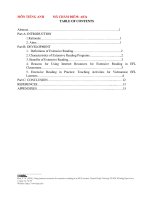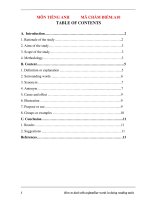How to activate reading and listening in ppsx (Cách kích hoạt Đọc Nghe trong Phòng thí nghiệm Ngôn ngữ Anh)
Bạn đang xem bản rút gọn của tài liệu. Xem và tải ngay bản đầy đủ của tài liệu tại đây (471.05 KB, 15 trang )
How to Activate
Reading &
Listening: English
Lab
Upper Classes
English Language
Department
Abdelmoneim Hassan Adam Khamis
0557083091
1. Introduction
PPP to EAS
“Tell me, I forget.
Show me, I remember.
Involve me, I understand.”
Confucius, circa 450BC
Shift from Teaching to Learning
Prepared by Abdelmoneim Hassan Adam Khamis
2
2. The
Focus
Combining Reading with Listening
Engage and involve Learners
More
exposure to English
Language
Backward
Design
(begin with the end in mind)
through:
1. What should students know & be
1)
2)
Listening
Reading
1. What should students know & be
able to do?
2. How will students demonstrate what
they know & can do?
3. What activities will students
experience to prepare them to
demonstrate what they know & can
do?
Stephen
Covey, 1996
Prepared by Abdelmoneim Hassan Adam Khamis
3
3. Overview
1.
Material Structure:
2.
Who compiles learning resources? (Sample)
3.
In the lab:
4.
What’s the teacher’s role in the EL Lab?
5.
Why? The Theoretical Framework
6.
Recap:
Prepared by Abdelmoneim Hassan Adam Khamis
4
3.1. Material Structure
a)
Interactive CD
b)
Practice CD
c)
Carton Movie DVD
d)
Enrich Materials
e)
Short Stories
Prepared by Abdelmoneim Hassan Adam Khamis
5
The Structure of
Material
Interac
tive CD
Cartoo
n
Movie
DVD
Enrich
Materi
als
Practic
e CD
Short
Stories
Prepared by Abdelmoneim Hassan Adam Khamis
6
3.2. Who compiles the
resources?
1.
Cooperative work
2.
Collaborative work
3.
Lab Teacher edits, classifies and grades the
materials to levels alongside weekly lesson plan.
Prepared by Abdelmoneim Hassan Adam Khamis
7
3.3. In the English Lab
1.
No Students’ Books
2.
No Workbooks
3.
No Worksheet
Learning through experience
Learning by games
Learning by doing
Prepared by Abdelmoneim Hassan Adam Khamis
8
3.4. What is the
Teacher’s Role?
1.
Designs activities _ “Backward Designer”.
2.
Scaffolds learning activities.
3.
Creates learning environment.
4.
Facilitates learning.
5.
Guides learners.
6.
Assesses/evaluates learners’ abilities.
All the roles should be
done through CALL.
Prepared by Abdelmoneim Hassan Adam Khamis
9
3.5. Why? Theoretical
Framework
A Mixed approach:
1.
Learning through experience
(Dewey, 1938)
2.
Multiple Intelligences Theory
(Gardner, 2001, 1983-93)
3.
Cognitive & Metacognitive Strategies
4.
Input Hypothesis
5.
Active Learning
6.
Bloom’s Taxonomy
7.
Backward Design
(constructivism)
(Krashen, 1988 & 1987)
(Kagan, 1998)
(Revised Hierarchy 2001)
(Stephen Covey, 1996)
Prepared by Abdelmoneim Hassan Adam Khamis
10
The Main Schools of Learning
Behaviorism
Structural View
Change in Behavior
Cognitivism
Constructivism
Functional View
Interactional View
Change in information
Change in Knowledge
Habit formation
Convey meaning
Interaction &
Negotiation of Meaning
S ------ R
Mental Process
Knowledge construct
1- Gestalt’s Insight, 1950s
2- LAD/UG by Chomsky, 1960s & 70s
3- The Monitor Model by Krashen, 1980s
12/22/2014
Prepared by Abdelmoneim Hassan Adam Khamis
3.6. Recap:
1.
Reading & Listening are psycholinguistics games.
2.
Practice Listening
3.
Gear Reading to Listening
4.
How to evaluate/assess listening & Reading?
Individually, we can evaluate/assess Learners’
Reading through Practicing Listening.
Prepared by Abdelmoneim Hassan Adam Khamis
12
Conclusion
Education is what people do for others.
Learning is what learners do for him/herself.
Reading Power Increases Learning.
Prepared by Abdelmoneim Hassan Adam Khamis
13
References:
Anderson, L.W., & Krathwohl (Eds.). (2001). A Taxonomy for Learning, Teaching, and Assessing: A Revision of Bloom's Taxonomy of
Educational Objectives. New York: Longman.
Bloom, B.S. and Krathwohl, D. R. (1956). Taxonomy of Educational Objectives: The Classification of Educational Goals, by a committee
of college and university examiners. Handbook I: Cognitive Domain. NY, NY: Longmans, Green.
Dewey, J. (1938). Experience and education. Kappa Delta Pi, 1938
Gardner, H. (1993). Multiple intelligences: The theory in practice. New York: Basic Books.
Gardner, H. (2006a). Multiple intelligences: New horizons in theory and practice. New York: Basic Books.
Krashen, Stephen D. (1987). “Second Language Acquisition and Second Language Learning.” University of Southern California. First
printed edition 1981 by Pergamon Press Inc. Print Edition ISBN 0-08-025338-5 First internet edition December 2002
Krashen, S. D. (2002). “The comprehension hypothesis and its rivals”, In Selected papers from the Eleventh International Symposium on
English Teaching/Fourth Pan-Asian Conference (pp. 395-404). English.
Krashen, S. D. (2004), The Power of Reading. Portsmouth, NH: Heinemann.
Krashen, S. D. (2004). “Free Voluntary Reading: New Research, Applications, and Controversies”, The Paper presented at the RELC
conference, Singapore, April, 2004.
Krashen, S. D. (2013). “Reading and Vocabulary Acquisition: supporting evidence and some objections”, Iranian Journal of Language
Teaching Research 1(1), (Jan., 2013) 27-43.
Prepared by Abdelmoneim Hassan Adam Khamis
14
Thank you for
your time.
Prepared by
Abdelmoneim Hassan Adam Khamis
Al-Aqsa School, Upper Classes
English Department
Dec, 2015
Prepared by Abdelmoneim Hassan Adam Khamis
15





![have a nice conflict [electronic resource] how to find success and satisfaction in the most unlikely places](https://media.store123doc.com/images/document/14/y/zs/medium_zsa1401356484.jpg)



